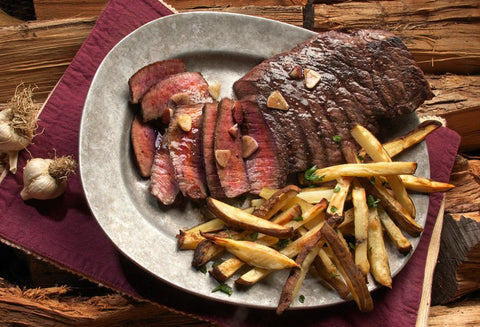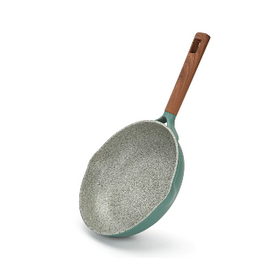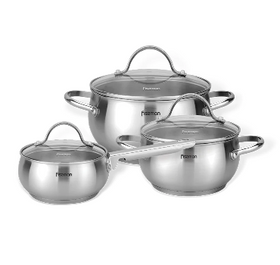
Steps to the Perfect Pan-Fried Steak
Steaks are one of the most popular meals out there. They're easy to cook and versatile: you can pair them with almost anything (we recommend potatoes and veggies if you want to keep things simple). You can also change the flavor profile by marinating or seasoning them differently each time. And best of all? Steaks are delicious.
But sometimes, that perfect steak gets ruined by not having enough flavor or texture on the outside of the meat itself. That's why we're here today: to show you how to make your next pan-fried steak as flavorful as possible so it'll be worth every bite.

Step 1: Tools and Ingredients
The first thing you need to do is gather your ingredients and tools. You'll need:
- Pan
- Knife
- Stove
- Tongs
- Olive oil
- Beef tenderloin steak, about 1 inch thick
- Salt
- Butter
- Garlic
Step 2: Selecting a Steak
The first thing to consider when buying steak is your budget. You will need to pay more if you are looking for the best quality. However, many options are available if you are looking for something less expensive that still tastes good. Once you have decided what type of steak you want and how much money you want to spend, it's time to start looking at different cuts of meat.
One option is ribeye steaks. Ribeye steaks come from the rib section of beef cattle and are very tender and flavorful because they have lots of marbling throughout the meat. These cuts can be pricey, but they are worth it if you want something delicious.

Another popular choice is strip steak. Strip steaks come from either side of a cow's lower ribs and are known for their tenderness and flavor. They're also inexpensive compared to other cuts, so this would be a good choice if money is tight, but you still want something good.
Filet mignon is a beef cut taken from the tenderloin's smaller end. It consists of a single muscle without any connecting fat or gristle. It does not benefit aging, so it is usually served as soon as possible after butchery.
Filet mignon is often served with béarnaise sauce, although other sauces such as Bearnaise and mushroom sauce are also popular. It is also often cooked whole and then sliced into medallions before being served.
Porterhouse steak is a cut of beef taken from the short loin (also known as the strip loin) on both sides of the backbone. A porterhouse steak is considered one of the tastiest cuts of beef available because it contains two different muscles: tenderloin (the most tender part) and top loin (the less tender part). It is so named because it resembles a porter's carrying pole (or "porterhouse").
Each of these cuts will have different fat content and marbling (the amount of visible fat within the meat), which will affect your steak's overall flavor and texture.
Step 3: Preparing the Meat
Once you've made sure your pan is nice and hot, it's time to add your meat! We like to use a cast iron skillet for our steaks because it helps seal in juices and adds an extra layer of flavor. If you don't have a cast iron skillet, any other pan will work just fine—just make sure it's large enough to fit your steak but not so big that it takes up too much space on your stovetop.
If your steak is frozen, let it thaw at room temperature for about 20 minutes before cooking. If it isn't frozen, or if you want to cook it immediately after purchasing, go ahead and put it straight into the pan!
Slice open the package of meat and remove any plastic wrap or butcher paper that covers the outside of the meat. Wipe down both sides with a wet paper towel or clean kitchen towel. This will remove any excess salt or seasoning from the packaging.
You can easily do it at home if your butcher does not season the meat. First, pat dry your meat with a paper towel. Then, season it liberally with salt and pepper on both sides. This will help to draw out moisture from the meat and give it a more seasoned flavor.
Next, pat dry with another clean kitchen towel or paper towel. This will help ensure that your steak doesn't stick to the pan when cooked.
Step 4: Searing the Steak

Once you've seasoned your steak, it's time to get down to business. In this step, you will be searing the steak—a process that involves cooking the meat over high heat in a small amount of oil until it gets browned and crusty on all sides. This step is crucial because it allows you to lock in moisture and flavor from marinades or rubs into the meat, which will help ensure your steak is tender and delicious.
Heat some oil in a large pan over medium-high heat. Pour some into the pan and spread it around so that you have enough oil to cover approximately half of the surface area of your steak when you put it in. Be careful not to add too much oil—you don't want your steak to be swimming in it.
Season both sides of your steak with salt and pepper before putting it in the pan; this helps season as much surface area as possible while also helping improve browning.
For best results, don't move your steak around too much during this process—just let it sit on one side until it's time to flip it over. It's okay if you have some burnt spots here and there; just make sure that the majority of your steak gets nice and browned.
Leave your heat on medium-high and let the steak sit in one place for about 2 minutes. Then, flip it over and cook for another 2 minutes. Repeat this process until you've cooked both sides of your steak for 4-5 minutes per side (the exact amount will depend on how thick your meat is). You can adjust that timing depending on how well-done you like your meat.
Step 5: Cooking the Steak
When your pan-fried steak is seared, it's time to cook it.
The procedure to follow is simple: add butter and garlic to the pan and let them melt over medium heat. You can add salt and pepper if you want, but they're unnecessary. Then put your steak on top of the butter and garlic, and let it sit for about three minutes so the meat can absorb all that delicious flavor before flipping it over and repeating the process on the other side.
You'll know when your steak is done by pressing on it with tongs—if it feels firm in the middle without being hard to press down, then you're good to go.
Step 6: Resting the Meat
After cooking your steak, you may want to rest it for a few minutes before slicing and serving. This will allow the juices to redistribute throughout the meat and make it juicier. You can also use this time to prepare side dishes like mashed potatoes or salads.

If you're cooking pan-fried steaks for guests, it's best not to slice them until everyone has arrived at the table so that they don't get cold sitting out on a platter while waiting for everyone else.
Sides That Pair Well With Steak
The perfect pan-fried steak is a thing of beauty. But what about the sides?
Whether you're pairing your steak with a baked potato or asparagus, there are many delicious options. Here are a few of our favorites:
Potato Gratin
This side dish is just potatoes, cream, cheese, and bacon. What else do you need?
Crispy Mashed Potatoes
Mashed potatoes take on an extra-special twist when they're fried until crispy—and then topped with chives.
Steak Fries
Who says steak has to come with baked potatoes or rice? These steak fries are everything you want in a side dish: salty, crispy goodness that's perfect for dipping into salsa.
Baked Potatoes
We love baked potatoes because they're so versatile. They can be loaded up with whatever you have on hand—from chili to guacamole to spinach salad—and they pair well with just about any kind of protein (steak included).
Asparagus or Brussel Sprouts
The vegetables tend to get overlooked when pairing them with steak, but they're a great choice because they're light and fresh. They also help cut through the richness of the meat.
These veggies pair perfectly with steak because they have a slightly bitter flavor that compliments steak's rich, savory taste. Asparagus also has a crisp texture that adds an extra crunch to each bite, while brussels sprouts add an earthy flavor and soft chewiness. And both veggies are high in vitamins and minerals like vitamin C and manganese.
Compound Butter
Compound butter is made by melting butter and then mixing in herbs and spices (like parsley and garlic powder). You can add whatever flavorings you like—the options are endless! This makes for an easy way to add another layer of flavor without having to spend time making a sauce from scratch.
Sauces that Pair Well With Steak
Italian Salsa Verde
This sauce is popular in Italy and can be used as an appetizer or as an accompaniment to your main course. It's made from fresh parsley, garlic, anchovies, and capers and is served over grilled meat or fish. It's also delicious on bread or crackers as an appetizer before dinner.
Sweet Chili Sauce
Sweet chili sauce is typically available in Asian markets and supermarkets, but you can make your own if you don't want to buy it pre-made. Sweet chili sauce is made by mixing sweet chili sauce with ketchup or tomato paste before adding vinegar and sugar or honey, depending on your preference for sweetness.
You can use sweet chili sauce as a dipping sauce for shrimp or other seafood appetizers, but it tastes great on steak sandwiches and burgers.
Blue Cheese Butter
Blue cheese is often used as a condiment for steak because it adds a savory flavor that compliments the meat well. This blue cheese butter recipe can be made ahead of time and stored in the refrigerator until you are ready to use it. It's perfect for serving with steaks at your next cookout.
Chimichurri
Chimichurri is another popular steak condiment found in Argentina. It originated from Italian immigrants who brought their love of herbs with them when they moved to South America.
Chimichurri has become a staple of Argentine barbecue and is often served alongside grilled meats, poultry, and fish. Chimichurri is made by combining olive oil with chopped garlic, parsley, oregano, onion, vinegar, and sometimes other herbs such as cilantro or basil.
Aioli
Aioli is a garlic- and olive oil-based sauce in many Mediterranean cuisines. It's typically served with fish, seafood, and vegetables, but it also pairs well with steak. The sauce is made by emulsifying garlic, egg yolk, lemon juice, and olive oil together until they form a thick, mayonnaise-like consistency.
Aioli is often served as a dip or side dish on top of the steak. It can also be used as a marinade for cooking steak or as a dipping sauce when serving steak at the table. In addition to the classic French version of this sauce, many variations, such as chipotle aioli or avocado aioli, offer new flavors and textures to your meal.
Choosing a grill pan!
Fissman grill pan can help you bring cooking to a new level! Steaks from meat, poultry or fish will turn out juicy, grilled vegetables will retain their freshness and all useful properties, and thanks to the ribbed surface, the excess fat will not fall on the plate, it will simply remain in the pan. Beautiful stripes formed during frying will decorate any dish and make it very appetizing.
Final Word
It's not only a matter of the right cut but also of the right cooking method.
As with any meat, the most important thing to consider when pan-frying steaks is to ensure they are cooked until done. The best way to do this is by using an instant-read thermometer — it will take you out of the guessing game and tell you exactly when your steak is ready.
A timer will come in handy if you don't have access to such a gadget. For rare steaks, cook them for about two minutes per side. For medium-rare steaks, cook them for about three minutes per side. And for medium steaks, cook them for about four minutes per side.
Sources
https://www.instructables.com/How-To-Pan-Fry-the-Perfect-Steak/
https://sevensons.net/blog/how-to-pan-fry-a-steak
https://www.foodandwine.com/condiments/11-sauces-serve-grilled-steak



































Leave a comment